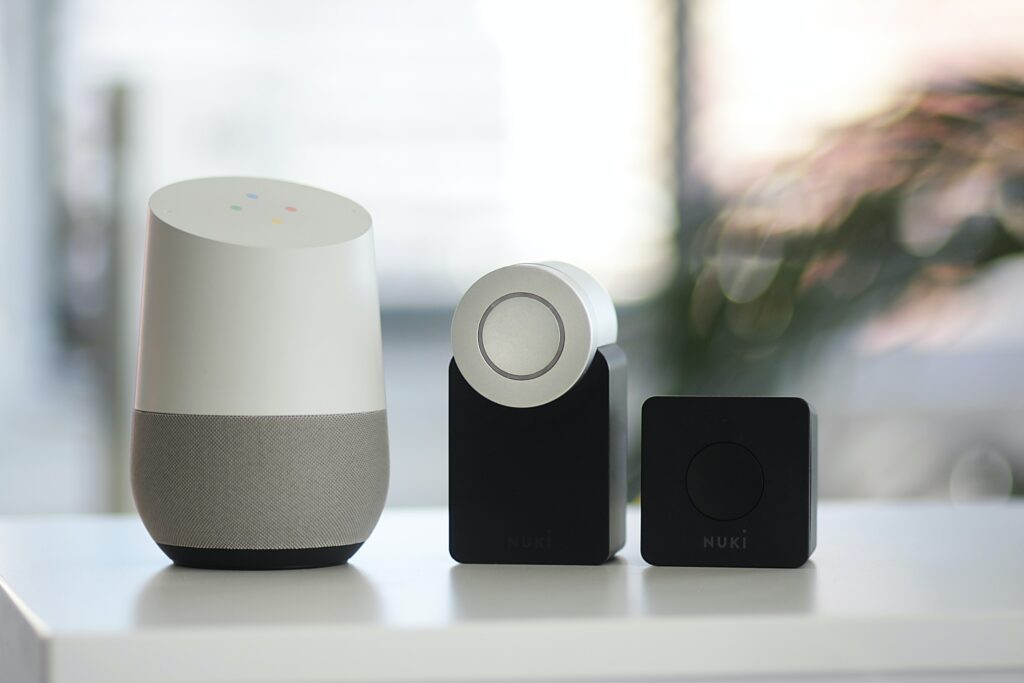Thanks to advancements in technology, setting up a smart security system for your home is now not only a feasible option but a wise one. This comprehensive guide will take you through the process of setting up a smart security system step by step.
From security cameras to sensors and alarms, we’ll cover all the essential components and considerations to help you build a robust and effective smart security system tailored to your needs.
Why Invest in a Smart Security System?

Before we dive into the nitty-gritty details of setting up your smart security system, let’s briefly explore why you should consider this investment:
- 24/7 Surveillance: Keep an eye on your property and loved ones at all times, even when you’re away from home.
- Burglary Deterrence: Smart security systems act as a strong deterrent to potential burglars and intruders.
- Quick Emergency Response: Receive instant alerts and notifications in case of suspicious activity, fires, or other emergencies.
- Integration: Seamlessly integrate your security system with other smart home technology for enhanced automation and convenience.
Now, let’s embark on the journey of setting up your smart security system.
I. Assessing Your Security Needs
Before you start purchasing components for your smart security system, it’s crucial to assess your specific security needs. Every home is unique, and your security system should be tailored accordingly.
A. Identifying Vulnerabilities
1. Exterior Entry Points
Begin by examining your home’s exterior. Identify potential entry points for intruders, such as doors, windows, and other openings. Take note of any weaknesses that might need additional security.
2. Interior Access Points
While external security is essential, don’t overlook the interior of your home. Consider how to protect areas like basements and upper floors.
3. Valuables and High-Risk Areas
Determine the locations of your most valuable possessions. These areas may need extra security measures, like safes or additional sensors.
B. Defining Your Security Objectives
1. Burglary Prevention
Is your primary goal to prevent break-ins and theft? If so, you’ll want a system with robust intrusion detection features.
2. Fire and Environmental Monitoring
Do you want to safeguard your home against fire, carbon monoxide, or other environmental hazards? Ensure your system includes the necessary detectors and alerts.
3. Remote Surveillance
Are you frequently away from home and want to keep tabs on your property remotely? Look for a system that offers real-time monitoring through a mobile app.
4. Integration with Other Smart Home Devices
If you have other smart home devices like lights, thermostats, or smart locks, consider how your security system can integrate with them for added convenience and automation.
II. Choosing the Right Smart Security Components

With a clear understanding of your security needs, it’s time to choose the components that will make up your smart security system. Each component plays a vital role in ensuring the overall effectiveness of your system.
A. Control Panel
The control panel serves as the brain of your security system. It’s where you arm and disarm the system, receive alerts, and manage settings.
1. Features and Functions
When selecting a control panel, consider the features it offers, such as touchscreen displays, backup battery power, and cellular connectivity for uninterrupted operation, even during power outages.
2. Wired vs. Wireless Options
Decide whether you prefer a wired or wireless control panel. Wireless options are more flexible and easier to install but may require regular battery changes.
B. Security Cameras
Security cameras are the eyes of your system, providing visual surveillance of your property.
1. Types
- Indoor Cameras: Monitor the interior of your home.
- Outdoor Cameras: Keep an eye on your property’s perimeter.
- Doorbell Cameras: Capture footage of visitors at your front door.
2. Resolution and Field of View
Opt for cameras with high-resolution capabilities and a wide field of view to capture clear images and cover more area.
3. Motion Detection and Night Vision
Choose cameras equipped with motion detection and night vision to capture footage in low-light conditions and trigger alerts when motion is detected.
C. Sensors
Sensors are the frontline detectors that identify potential threats and trigger alarms.
1. Window and Door Contacts
Install window and door contacts on all accessible entry points. These sensors will alert you if a door or window is opened.
2. Motion Sensors
Place motion sensors in key areas within your home to detect movement.
3. Glass Break Sensors
Glass break sensors can detect the sound of shattering glass, providing an additional layer of protection.
4. Smoke and Carbon Monoxide Detectors
Integrate smoke and carbon monoxide detectors into your system to ensure early detection of fire or gas leaks.
D. Alarms and Sirens
Audible alarms and sirens alert you and your neighbors to potential intrusions or emergencies.
E. Smart Locks
Smart locks allow you to control and monitor access to your home remotely. They can be integrated into your security system for added convenience and security.
F. Monitoring Services
Choose between self-monitoring and professional monitoring services. Self-monitoring means you’ll receive alerts directly, while professional monitoring involves a third-party company that can dispatch help in case of an emergency.
III. Setting Up Your Smart Security System
With all your components in hand, it’s time to set up your smart security system. Proper installation ensures that your system functions optimally.
A. Designing the System Layout
1. Camera Placement
Decide where to position your cameras for the best coverage. Place outdoor cameras near entry points and vulnerable areas.
2. Sensor Placement
Strategically place sensors on doors, windows, and other entry points. Ensure motion sensors cover high-traffic areas.
3. Integration with Entry Points
Integrate your smart locks with your security system, allowing you to control access remotely and receive alerts when doors are unlocked.
B. Installing Hardware
1. Mounting Cameras
Follow the manufacturer’s instructions to securely mount your cameras, ensuring they have a clear line of sight and are protected from tampering.
2. Placing Sensors
Position sensors at the recommended heights and angles for optimal performance. Test each sensor to ensure it’s working correctly.
3. Connecting Alarms and Sirens
Connect audible alarms and sirens in prominent locations to deter potential intruders and alert you to emergencies.
4. Smart Lock Installation
Install smart locks on your doors, following the provided instructions. Sync them with your control panel and app for remote access.
C. Wiring and Connectivity
1. Wiring Options (Wired vs. Wireless)
If your system includes wired components, ensure proper cable management and connections. Wireless systems require a strong and secure Wi-Fi network.
2. Network Connectivity
Connect your security system to your home network, ensuring a stable internet connection for remote access.
D. Power Sources and Battery Backup
Ensure all components have a reliable power source. Consider battery backup for essential components in case of power outages.
E. Configuring Control Panel and Devices
1. Setting Up User Accounts
Create user accounts for your security system’s mobile app and control panel. Set up unique access for each user.
2. Pairing Devices
Follow the manufacturer’s instructions to pair your devices with the control panel and app. Test each device to ensure they communicate correctly.
3. Testing Sensors and Cameras
Conduct thorough testing of all sensors and cameras to verify their functionality. Adjust settings as needed to optimize performance.
IV. Integrating Your Smart Security System with Other Devices

Enhance your smart security system’s functionality by integrating it with other smart home devices.
A. Smart Home Hub Integration
If you have a smart home hub, integrate your security system with it to streamline automation and control.
B. Mobile App Integration
Download and configure the mobile app for your security system. Ensure you can access and control your system remotely.
C. Voice Assistant Integration
Integrate your security system with voice assistants like Amazon Alexa or Google Assistant for hands-free control.
D. Home Automation Scenarios
Create automation scenarios that link your security system with other devices. For example:
1. Lights and Thermostat Control
Automatically adjust lighting and thermostat settings based on security system status.
2. Security Scenes
Create custom security scenes that arm or disarm your system with a single command or tap in the app.
V. Remote Monitoring and Control
Once your smart security system is set up and integrated, it’s essential to understand how to monitor and control it remotely.
A. Mobile App Usage
Learn how to use the mobile app to access live camera feeds, receive alerts, and control your system while away from home.
B. Web-Based Control Panels
Some security systems offer web-based control panels for advanced settings and monitoring. Familiarize yourself with these options.
C. Real-time Alerts and Notifications
Configure alerts and notifications to receive instant updates about security events, such as motion detection or system alarms.
VI. Maintenance and Troubleshooting
To ensure your smart security system remains effective, you must perform routine maintenance and be prepared for troubleshooting.
A. Routine System Checks
Regularly check your cameras, sensors, and alarms to ensure they are functioning correctly.
B. Software Updates
Stay up-to-date with firmware and software updates to maintain system security and performance.
C. Battery Replacement
Monitor battery levels and replace batteries in sensors and devices as needed to avoid downtime.
D. Troubleshooting Common Issues
Familiarize yourself with common issues and their solutions, such as Wi-Fi connectivity problems or false alarms.
VII. Security and Privacy Considerations
Security and privacy should remain paramount when setting up a smart security system.
A. Protecting Your Data
Implement robust security measures to safeguard your system from hacking and data breaches.
B. Securing Your Network
Ensure your home network is secure by using strong passwords and encryption protocols.
C. User Access Control
Manage user access and permissions to prevent unauthorized individuals from controlling your security system.
D. Legal and Ethical Considerations
Understand the legal and ethical responsibilities related to surveillance and data collection in your region.
Conclusion
With the right components, proper installation, and ongoing maintenance, you can enjoy the peace of mind that comes with knowing your home is secure.
Remember that technology evolves, so stay informed about updates and new features for your system. As you continue to invest in the safety of your home, you’ll be better prepared to protect what matters most to you.
Frequently Asked Questions (FAQs)
1. What should I look for in a smart home security system?
When choosing a smart home security system, consider your specific needs, including surveillance, intrusion detection, and remote monitoring. Look for reliable components like cameras, sensors, and alarms, and consider integration with other smart home devices for added convenience.
2. What is the easiest home security system to set up?
Wireless smart security systems are generally the easiest to set up, as they don’t require complex wiring. Look for systems with user-friendly mobile apps and straightforward installation instructions.
3. How do smart security systems work?
Smart security systems use a combination of sensors, cameras, and alarms to monitor your home. When a sensor detects motion or a breach, it sends a signal to the control panel, which can then trigger alarms, send alerts to your devices, or contact a monitoring service.
4. Which security system is best for my home?
The best security system for your home depends on your specific needs and preferences. Consider factors like the size of your home, the level of security you require, and any integration with existing smart home devices. It’s wise to research and compare different options before making a decision.
5. How many cameras do you need for home security?
The number of cameras you need depends on the size and layout of your home. At a minimum, consider cameras for each exterior entry point and key indoor areas. You can always add more for additional coverage and peace of mind.
6. What are the three types of security systems?
The three primary types of security systems are intrusion detection, fire and environmental monitoring, and video surveillance. Intrusion detection systems alert you to unauthorized entry, fire and environmental systems monitor for hazards like fires or gas leaks, and video surveillance systems provide visual monitoring of your property.



